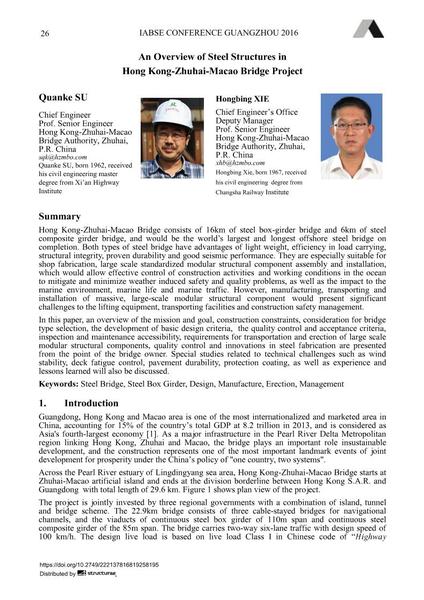An Overview of Steel Structures in Hong Kong-Zhuhai-Macao Bridge Project

|
|
|||||||||||
Détails bibliographiques
| Auteur(s): |
Quanke Su
Hongbing Xie |
||||
|---|---|---|---|---|---|
| Médium: | papier de conférence | ||||
| Langue(s): | anglais | ||||
| Conférence: | IABSE Conference: Bridges and Structures Sustainability - Seeking Intelligent Solutions, Guangzhou, China, 8-11 May 2016 | ||||
| Publié dans: | IABSE Conference, Guangzhou, China, 8 – 11 May 2016 | ||||
|
|||||
| Page(s): | 26-35 | ||||
| Nombre total de pages (du PDF): | 10 | ||||
| Année: | 2016 | ||||
| DOI: | 10.2749/222137816819258195 | ||||
| Abstrait: |
Hong Kong-Zhuhai-Macao Bridge consists of 16km of steel box-girder bridge and 6km of steel composite girder bridge, and would be the world’s largest and longest offshore steel bridge on completion. Both types of steel bridge have advantages of light weight, efficiency in load carrying, structural integrity, proven durability and good seismic performance. They are especially suitable for shop fabrication, large scale standardized modular structural component assembly and installation, which would allow effective control of construction activities and working conditions in the ocean to mitigate and minimize weather induced safety and quality problems, as well as the impact to the marine environment, marine life and marine traffic. However, manufacturing, transporting and installation of massive, large-scale modular structural component would present significant challenges to the lifting equipment, transporting facilities and construction safety management. In this paper, an overview of the mission and goal, construction constraints, consideration for bridge type selection, the development of basic design criteria, the quality control and acceptance criteria, inspection and maintenance accessibility, requirements for transportation and erection of large scale modular structural components, quality control and innovations in steel fabrication are presented from the point of the bridge owner. Special studies related to technical challenges such as wind stability, deck fatigue control, pavement durability, protection coating, as well as experience and lessons learned will also be discussed. |
||||
| Mots-clé: |
design pont en acier
|
||||
